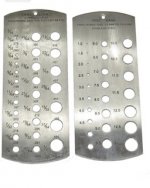Anyone who has made the Headwind pen can you tell me what size drill bit you used please.
I have it as 11/32 but after I drilled that size I could not get the tube in the blank, the fit is very snug at the start and only manages to go in about an inch before being too tight (Needed pliers to pull it out)
If you all use the 11/32" bit then 1 of 2 things is stopping me progressing, 1) my drill bit is slightly undersized or 2) The play I have on my tailstock is affecting the drilling and producing a slight bend (I've seen rocking horses with less movement than my tailstock has) if it was the 2nd option then I would be having the same problem with all of the pens I turn.
Anyone know of a solution or do I need to save the dosh I get each month and buy a new model in the new year sometime? Axminster Craft AC240WL Woodturning Lathe - 230V | Axminster Tools
I have it as 11/32 but after I drilled that size I could not get the tube in the blank, the fit is very snug at the start and only manages to go in about an inch before being too tight (Needed pliers to pull it out)
If you all use the 11/32" bit then 1 of 2 things is stopping me progressing, 1) my drill bit is slightly undersized or 2) The play I have on my tailstock is affecting the drilling and producing a slight bend (I've seen rocking horses with less movement than my tailstock has) if it was the 2nd option then I would be having the same problem with all of the pens I turn.
Anyone know of a solution or do I need to save the dosh I get each month and buy a new model in the new year sometime? Axminster Craft AC240WL Woodturning Lathe - 230V | Axminster Tools


 )
)



